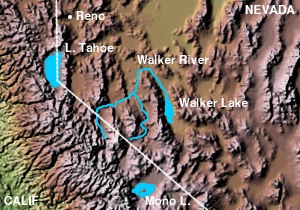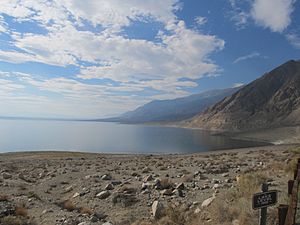Walker Lake (Nevada) facts for kids
Quick facts for kids Walker Lake |
|
|---|---|

Walker Lake with Hawthorne Army Depot in the foreground
|
|
| Location | Mineral County, Nevada, United States |
| Coordinates | 38°41′32″N 118°44′10″W / 38.69222°N 118.73611°W |
| Primary inflows | Walker River (Does not reach Walker Lake in most years) |
| Primary outflows | evaporation |
| Catchment area | Walker River Basin |
| Basin countries | United States |
| Max. length | 11 mi (18 km) |
| Max. width | 5 mi (8.0 km) |
| Surface area | 130 km2 (50 sq mi) |
| Max. depth | 68 ft (21 m) |
Walker Lake is a natural lake in western Nevada, United States. It is part of the Great Basin area. The lake is about 11 miles (17 km) long and 5 miles (8 km) wide. It is located in Mineral County, near the Wassuk Range.
The lake gets its water from the Walker River in the north. Walker Lake has no natural way for water to leave it, except through evaporation. The small town of Walker Lake, Nevada is located along its southwest shore.
Contents
History of Walker Lake
Walker Lake is a leftover from a much larger ancient lake called Lake Lahontan. This huge lake covered much of northwestern Nevada during the ice age. Scientists have studied Walker Lake's past to understand the climate of the region.
The lake is named after Joseph R. Walker. He was a mountain man who explored the area with John C. Frémont in the 1840s. The land around the lake has been home to the Paiute for a very long time.
Why Walker Lake is Shrinking
Starting in the mid-1800s, farming began upstream from Walker Lake. Farmers started taking water from the Walker River to water their crops. This has caused the lake's water level to drop a lot.
The USGS says the lake level dropped about 181 feet (55 meters) between 1882 and 2016. By June 2016, the lake was at its lowest level since measurements began.
Impact on Fish and Birds
When the lake level drops, the water becomes saltier. This is because the same amount of salt is in less water. As of 2016, the saltiness was too high for most of the native fish.
- The Lahontan cutthroat trout no longer live in the lake.
- The lake's tui chub fish have also almost disappeared. The salty water kills their eggs and young fish.
The loss of fish has a big effect on birds that use the lake. Walker Lake used to be a major stop for migrating loons. But by 2009, the town of Hawthorne canceled its Loon Festival. This was because the lake could no longer provide enough fish to attract many loons.
Efforts to Save Walker Lake
Many people and groups are working to help Walker Lake. U.S. Senator Harry Reid helped create a law in 2002. This law, called the Desert Terminal Lakes Program, aimed to provide water to at-risk desert lakes.
Later laws specifically directed money to help Walker Lake. This money was used to buy water rights from willing sellers. This means buying the right to use water from the Walker River. The goal is to let more water flow into the lake.
Funding for Conservation
Several laws have provided money for different efforts:
- In 2005, $70 million went to the University of Nevada. This was to buy land and water rights in the Walker River Basin. It also helped set up a center for research and restoration.
- $10 million was given for a water lease program for the Walker River Paiute Tribe.
- Another $10 million was for removing invasive plants like tamarisk. This also helped restore river areas to improve water flow to the lake.
- $5 million went to wildlife services to improve fisheries in the Walker River Basin.
More money was allocated in 2007 and 2008. This funding helped study the effects of low water on fish. It also helped prepare watershed inventories and support tribal water claims.
In 2009, more funds were added for:
- Collecting LIDAR data in the Walker River Basin. This helps map the land.
- Monitoring lakes in Nevada to see if they can support migratory loons.
The National Fish and Wildlife Foundation has been buying water rights to help the lake. They are working to get permission to send this water downstream to Walker Lake. In 2016, they bought the Flying-M Ranch for $19.4 million to help with these efforts.

More About the Area
The Walker Lake State Recreation Area, now called Monument Beach, is on the western shore. The Hawthorne Army Depot is located south of the lake. This is the world's largest ammunition storage area. U.S. Route 95 runs along the western side of Walker Lake.




